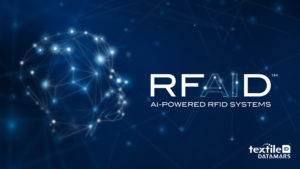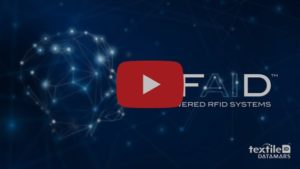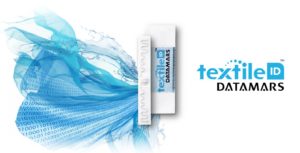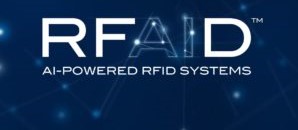
When artificial intelligence meets RFID:
Datamars Textile ID is paving the way for a New generation of reading systems.
Neural networks are used to recognize and filter stray reads with an unprecedented level of accuracy, deploying all the potential of fully automated identification and tracking of textiles.
For the first time in textile identification for the industrial laundry sector, a new technology based on artificial intelligence (AI) to unlock the full potential of radio frequency identification (RFID) systems has been developed.
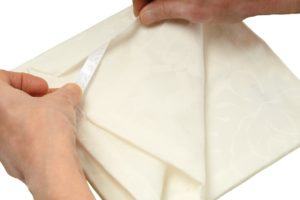
Datamars UHF RFID tags match any tag insertion need and are guaranteed for a minimum of 200 washing cycles to endure the harshest laundry conditions.
RFID identifies, tracks and traces textiles across their entire life cycle, providing amazing advantages for industrial laundries and their customers and for rental linen companies, hospitals, nursing homes, hotels, restaurants and other companies with their own laundry. However, technological challenges prevent making the most out of RFID systems. The constraint of stray reads – false-positive tags detected accidentally by the reader – and difficulties in correctly assigning readings to moving items are two limitations.
The use of machine learning algorithms ensures the most accurate identification to date, paving the way for a new generation of reading systems. This represents a real revolution and guarantees unprecedented precision in automated systems: avoiding stray reads; identifying moving textiles without interrupting the workflow; and correctly assigning tags to physical items, even in bulk.
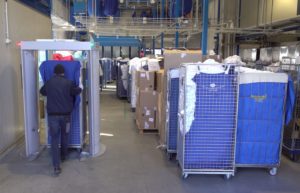
Datamars UHF Portal, one of the most used RFID reading system designed to read carts on the clean side. It can be used in any area were bulk reading is needed without slowing down the textile flow.
The objective of a RFID system is to identify and track textiles along their lifecycle, allowing for precise Datamars UHF Portal, one of the most used RFID reading system designed to read carts on the clean side. It can be used in any area were bulk reading is needed without slowing down the textile flow.and automated inventory management and loss reduction, the generation of transparent data and accurate invoicing, higher labor efficiency and increased profitability due to the optimization of textile cycles and lower costs for the replacement of lost textiles. The higher the RFID system accuracy is, the more these benefits are fully achieved.
But it’s not so easy. The curse and delight of UHF (ultra-high frequency) RFID technology is its ability to read tags without a line of sight and from a long distance. This enables the technology to read thousands of textiles in bulk in a few seconds, but risks the accidental read of unwanted tags in the surrounding area, especially when items are moving. This lowers the accuracy of the RFID data collection.
Until now, this challenge has mainly been addressed by containing and limiting the reading area as much as possible with mechanical shielding structures or by manually setting thresholds on reader parameters. This approach limits the flexibility of the RFID system and slows operations.
How does machine learning apply to RFID?
Datamars, for the first time in textile identification for the industrial laundry sector, has applied machine learning techniques to the RFID technology. Machine learning is a branch of artificial intelligence that provides systems the ability to learn and improve automatically through experience and without being explicitly programmed. It examines the provided “training” datasets to find common patterns and build a model to make decisions.
Using machine learning algorithms and a specifically developed neural network, the system exploits the information extracted from the data of all the RFID tag readings to classify each tag. In this way, instead of working to avoid stray reads, the system is able to recognize and discard them. In addition, “good” tags are correctly associated to the proper item/textile, even if they are in bulk and in motion.
By training the neural network with large amounts of data, the system does not require mechanisms, such as thresholds, to be set manually or with extensive and complex fine-tuning procedures. The greater the amount of data, the more precise and robust the neural network can become, easily adapting to multiple environments, use cases, and laundry evolutions. This enables a lower hardware investment and, since everything happens due to software algorithms, the reading system’s accuracy will improve over time with a simple software update and without dealing with hardware changes.
“Once again, Datamars is pushing the boundaries of RFID technology to create the most advanced textile identification solutions for the laundry sector,” said Riccardo Mazzolini, general manager, Datamars Textile ID. “Thanks to our pioneering use of artificial intelligence in laundry applications, we are offering the highest-performing UHF RFID reading systems of the market – more precise, flexible and adaptable – to deliver measurably better user experiences to our customers.”
For more info on our Artificial Intelligence Powered RFID Systems go HERE
Or learn more from our video: HERE
Learn more about our company: Datamars is one of the leading global suppliers of high performance unique-identification solutions, specializing in radio frequency identification (RFID) technology. With over 30 years of innovation and leadership in RFID, Datamars is a pioneer in electronic textile identification solutions for the industrial laundry process, developing important RFID-based patents & trademarks, inventing the LaundryChipTM in 1990, and today offering the most complete range of RFID identification solutions. Datamars is an ISO 9001 certified company and represents one of the few fully-integrated players in the RFID industry. The in-house product development and manufacturing, according to specific customer requirements, is its core capability and differentiating factor. For more information, please contact textile-id@datamars.com or visit www.textile.datamars.com.












